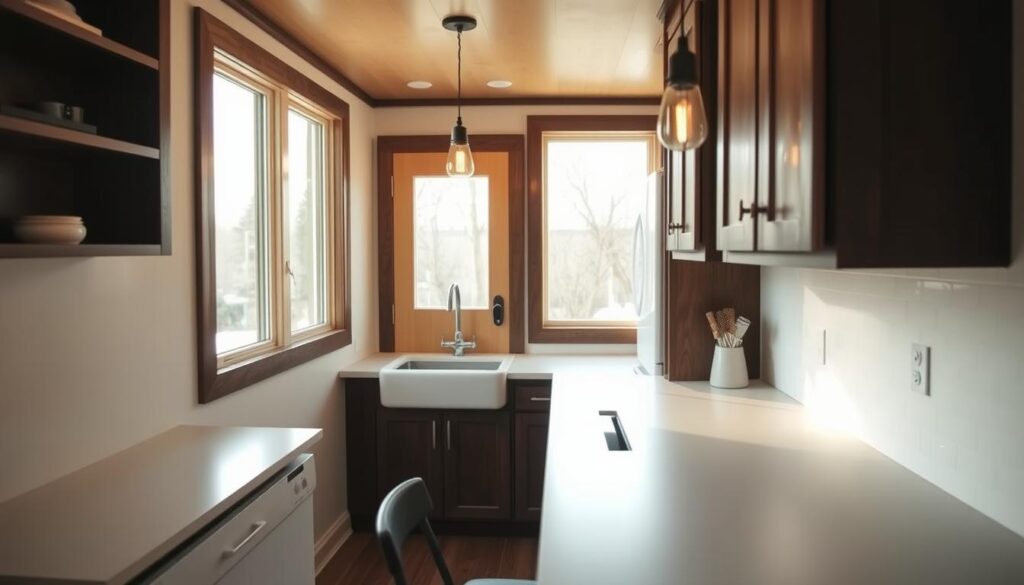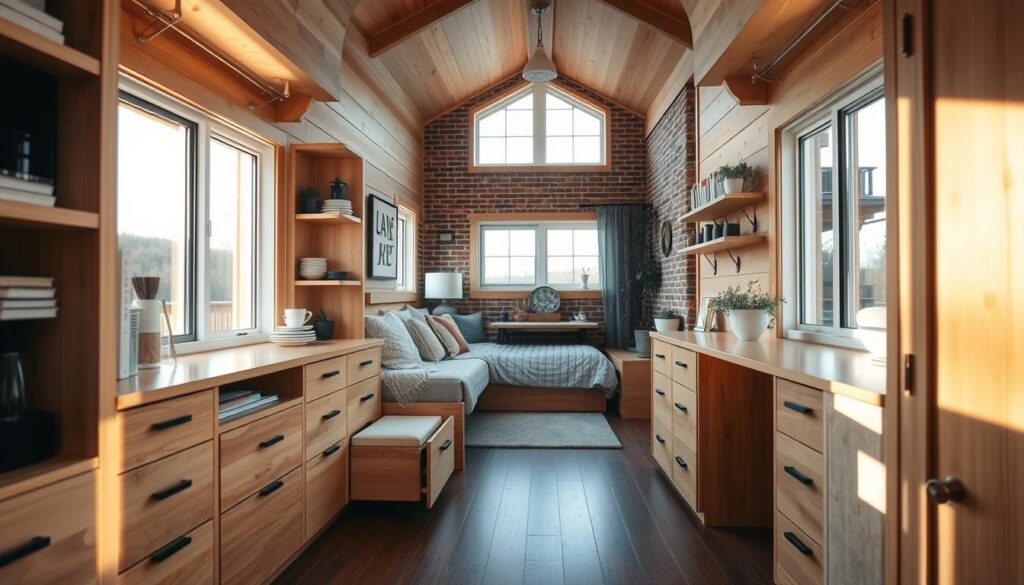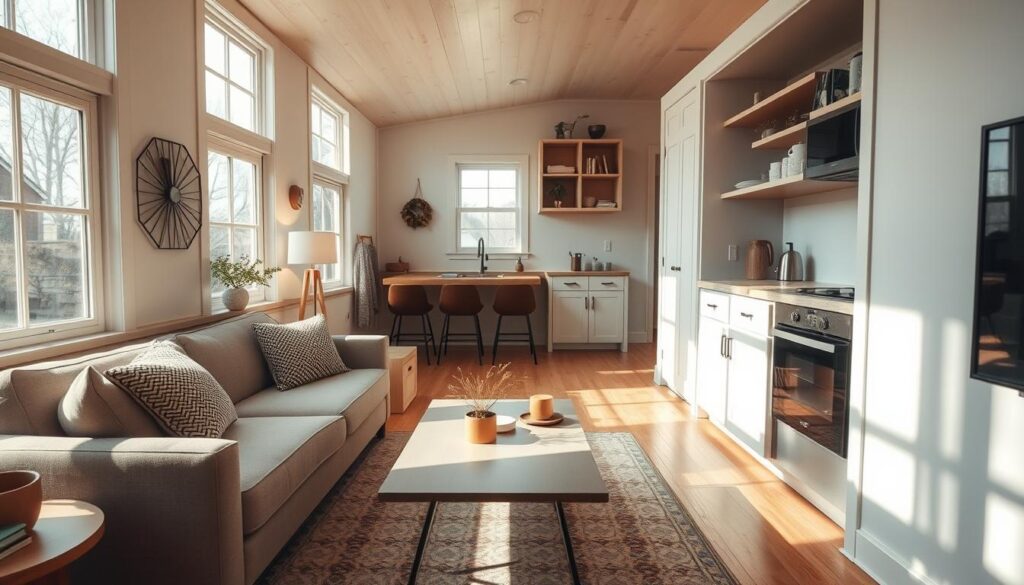Did you know the average tiny home is about 186 square feet? That’s roughly the size of a small studio apartment. This small space is both a challenge and an opportunity for creative interior design. The goal is to make the most of it while keeping it stylish and functional.
We know how to make a tiny home cozy and welcoming. In this article, we’ll share our best tips for a beautiful and efficient space. We’ll talk about embracing minimalism and using smart storage solutions. Our aim is to help you make your small home a cozy haven.
Key Takeaways
- Maximizing vertical space for optimal storage
- Selecting multi-functional furniture pieces
- Utilizing light colors to create a sense of spaciousness
- Incorporating mirrors to enhance the illusion of space
- Embracing minimalism for a clutter-free environment
Embracing Minimalism in Tiny Home Design
Minimalism in tiny home design makes living more efficient and peaceful. It helps tiny home dwellers enjoy a clutter-free, spacious, and functional space. This is achieved by following minimalist principles.
Understanding Minimalist Principles
Minimalist design focuses on simplicity and function. It means removing unnecessary items and keeping only what’s essential. In tiny homes, this means choosing each item wisely to make the space feel bigger and easier to keep up.
To apply these principles, clean lines, simple shapes, and a few colors are key. These elements bring calm and order, making the space feel larger.
Benefits of a Minimalist Approach
Minimalism in tiny home design has many benefits. It can reduce stress by clearing clutter and organizing the space. Plus, a minimalist home is easier to clean and maintain because there’s less to manage.
At our design studio, we help clients achieve efficient tiny homes with minimalist design. This boosts the home’s look and function.
Embracing minimalist living creates a focused and peaceful space. It teaches us to be mindful of our belongings and value what truly matters.
Creative Space Planning Strategies
In tiny homes, creative space planning is key. It’s not just a need, but an art. We must use every inch to make a cozy and useful living space.
Zoning Your Tiny Home
Dividing your tiny home into zones boosts its function. By setting up areas for different activities, you make your space more livable.
- Define different areas: Use rugs, curtains, or screens to mark off zones in your tiny home.
- Assign activities to zones: Set up areas for cooking, sleeping, working, and relaxing to keep things tidy.
- Optimize traffic flow: Make sure zoning doesn’t block movement in the home.
Multi-Functional Furniture Solutions
Multi-functional furniture is a big help for tiny homes. It saves space and makes your living area more versatile.
- Sofa beds: A sofa that turns into a bed is a top choice for multi-functional furniture.
- Storage ottomans: Ottomans with storage work as both seats and storage units.
- Drop-down tables: Tables that fold down when not in use are great for tiny kitchens or workspaces.
With these creative space planning tips, you can turn your tiny home into a spacious and cozy place. The secret is to be creative and flexible with your space.
Choosing the Right Color Palette
The right color palette can make or break a tiny home’s look. It affects both its coziness and sense of space. When designing a tiny home interior, think about how colors can change the space’s feel.
Light colors can make a space seem bigger, while dark colors add warmth. Light colors like whites and pale pastels reflect light, making areas feel larger. Dark colors like deep blues and warm browns create a cozy, intimate feel.
Light Colors vs. Dark Colors
Choosing between light and dark colors depends on your home’s natural light. If it’s bright, you can use many colors. But if it’s dim, light colors can brighten it up.
- Light colors make rooms feel larger and airier.
- Dark colors add depth and coziness.
- Think about your furniture and decor when picking colors.
Using Accent Colors Wisely
Accent colors add personality and interest to your tiny home. Use them to highlight features or create focal points. For example, a bold accent wall or vibrant textiles can make a cozy atmosphere.
“The key to using accent colors effectively is balance. Too many accent colors can make a space feel cluttered and chaotic.”
To look good, pick one or two accent colors that match your main colors. Use them in throw pillows, rugs, or decor.
Choosing colors wisely can make your tiny home feel more spacious and cozy. Whether you like light, airy colors or rich, dark ones, the right colors can turn your tiny home into a stylish, comfortable space.
Furniture Selection for Small Spaces
The right furniture can transform a tiny space into a cozy home. When designing a tiny home, it’s key to pick furniture that fits and adds function.
Choosing space-saving furniture is vital. This furniture does more than one thing, making the most of every inch. For example, a storage ottoman can be a seat and a place to store things. A murphy bed can turn a bedroom into a living area by day.
Types of Space-Saving Furniture
There are many space-saving furniture types that are great for tiny homes. Some favorites include:
- Nesting tables that stack when not in use
- Wall-mounted shelves for books and decor
- Foldable chairs and desks that hide away
- Multi-functional sofas that turn into beds
Customizing Your Furniture for Fit
While ready-made furniture is easy, custom furniture can change the game. Custom furniture fits perfectly in tight spots, making every inch count. For instance, a custom desk can fit in a corner, saving space.
Think about your home’s needs when customizing furniture. Consider what you’ll do in your tiny home and how to make furniture work for those activities. Custom furniture can help create a cozy and functional space, whether it’s for work, reading, or guests.
By picking and customizing furniture wisely, you can make your tiny home both beautiful and practical. The secret to great small space design is to be functional yet cozy.
Importance of Natural Light in Design
Natural light can change a tiny home, making it feel bigger and more inviting. It helps create a sense of openness and airiness, which is key for small spaces.
To get more natural light, there are several design tips. One good way is to make the most of windows. This lets lots of natural light into the room.
Maximizing Windows and Open Spaces
Think about where and how big your windows should be. Big windows or sliding glass doors let in more light. They also make a smooth transition from inside to outside.
| Window Type | Benefits |
|---|---|
| Large Windows | Provides ample natural light, expansive views |
| Sliding Glass Doors | Connects indoor and outdoor spaces, allows for natural light |
Designing a Functional Kitchen
In tiny homes, the kitchen is key. It needs careful planning to be both useful and space-saving. A well-thought-out kitchen greatly improves the home’s livability.
To make the most of tiny home kitchens, pick compact appliances. Look for microwave-toaster oven combos, small refrigerators, and induction cooktops. These save space and cut down on energy use.

Crafting Comfortable Living Areas
To make a tiny home’s living area cozy and practical, we need to find a balance. We focus on two main things: designing cozy nooks and picking versatile seating.
Designing Cozy Nooks
Cozy nooks are small spaces in the living area that are perfect for relaxing. We use compact furniture like storage ottomans or window seats with storage. This furniture does more than one thing.
To make these nooks even cozier, we add soft lighting, plush textiles, and warm colors. This makes the space feel bigger and more welcoming.
Choosing Versatile Seating Options
Versatile seating is key in a tiny home’s living area. It lets us change the space for different activities. We look for furniture that can be used in more than one way, like a sofa bed or a recliner with storage.
In micro living design, we aim to be both stylish and practical. By picking seating that’s both good-looking and useful, we make a space for relaxing, entertaining, or just enjoying quiet time.
Creating a cozy living area in a tiny home is all about making smart design choices. By focusing on cozy nooks and versatile seating, we make a space that’s both inviting and functional.
Efficient Storage Ideas
In tiny home design, finding ways to store things efficiently is key. It’s not just about having enough space; it’s about using it wisely. This helps keep your home tidy and organized.
One smart way to store things is through hidden storage techniques. These methods hide storage spots within the home’s design. This makes your home look neat and clutter-free, while still offering plenty of storage.
Hidden Storage Techniques
There are many ways to hide storage in your home. For example:
- Storage compartments under beds or sofas
- Hidden drawers within walls or furniture
- Ottomans or coffee tables with storage
These ideas not only save space but also make your home look better. They keep clutter hidden from view.
Vertical Storage Solutions
Using vertical storage solutions is another smart move. It makes the most of your home’s vertical space. This keeps the floor clear and makes your home feel more open.
| Storage Solution | Description | Benefits |
|---|---|---|
| Wall-mounted shelves | Shelves attached to the wall for storing books, decorations, etc. | Keeps floor clear, adds storage |
| Stackable containers | Containers that can be stacked on top of each other | Maximizes vertical space, versatile |
| Loft storage | Storage areas located above living spaces | Utilizes wasted space, keeps items out of the way |
By using these storage solutions, tiny home owners can enjoy a more organized and spacious living space.

Styling Small Bedrooms
Creating a cozy bedroom in a tiny home is all about finding the right balance. It’s important to think about both looks and function. This way, your small bedroom will feel welcoming and peaceful.
Creating an Inviting Atmosphere
To make your small bedroom feel inviting, choose calming colors and soft lighting. Light colors on walls and bedding can make the room feel larger. Table lamps or string lights add warmth without using too much space.
“The key to a restful bedroom is in the details – from the color of the walls to the texture of the bedding.”
For more ideas on designing small spaces, check out creative small space ideas. They can help you make the most of your bedroom.
Bed Alternatives for Space-Saving
In tiny homes, big beds can take up too much room. Looking into bed alternatives can really help. For example, murphy beds or wall beds can fold up against the wall when not in use. This frees up space for other activities.
| Bed Alternative | Space-Saving Benefit |
|---|---|
| Murphy Bed | Folds up against the wall |
| Platform Bed with Storage | Provides storage underneath |
| Daybed | Serves as both bed and seating |
Choosing the right bed alternative not only saves space but also makes the room more functional. Adding storage or multi-functional furniture can make the room more useful.
Sustainable Design Practices
Exploring tiny homes means thinking about their environmental impact. We can lessen our ecological footprint by using sustainable design. This makes our homes better for the planet.
Choosing the right materials is key in sustainable design. Eco-friendly options like reclaimed wood, bamboo, and low-VOC paints are great. They’re good for the environment and keep our homes healthy.
Eco-Friendly Materials and Furniture
Using eco-friendly materials and furniture is crucial for a green tiny home. Here are some ideas:
- Reclaimed or recycled materials for furniture and decor
- Sustainably sourced wood and bamboo products
- Low-VOC paints and finishes
- Energy-efficient appliances and lighting
These choices help us cut down on carbon emissions. They also make our homes healthier places to live.
Energy Efficiency and Appliances
Energy efficiency is vital in tiny home design. Look for appliances that use less power. This helps us use less non-renewable energy.
Outdoor Spaces in Tiny Homes
For tiny home dwellers, making the most of outdoor spaces is key. These areas can greatly improve our living experience. They offer a chance to expand our living space.
Integrating Outdoor Living Areas
To make outdoor living areas work, we need to think about design and function. Choosing compact furniture that does double duty is smart. This could be storage benches or foldable tables.
Outdoor spaces can be a game-changer. An outdoor deck or patio can become a new room for chilling or hosting guests. It’s also a chance to use tiny home storage ideas outside, like hidden spots under benches or in planters.
Benefits of Including a Deck or Patio
Adding a deck or patio to our tiny home brings many perks. It not only adds space but also boosts our home’s looks. A stylish outdoor area can also up our home’s value, making it more appealing to buyers.
| Benefits | Description |
|---|---|
| Additional Living Space | Expands the usable area of the tiny home for relaxation or entertainment. |
| Aesthetic Appeal | Enhances the visual appeal of the tiny home, making it more inviting. |
| Increased Property Value | Boosts the value of the tiny home, making it more attractive to potential buyers. |
With smart planning and design, our outdoor spaces can make our tiny home more livable and fun. Whether it’s a deck, patio, or smart storage, every detail matters in making our space work.
Personalizing Your Tiny Home Interior
When designing our tiny homes, making it our own is key. We add unique touches that show our personality and style. At the same time, we keep the space functional, as micro living design requires.
Unique Touches and Artwork
Adding personal artwork, family photos, or heirlooms makes our tiny home feel cozy. These elements add visual interest and warmth. They also bring out the character of our space.
Balancing Function and Aesthetics
To find a balance, think about furniture that does more than one thing. This keeps our tiny home tidy while showing off our style.
With these personal touches and a mix of function and beauty, we create a tiny home that’s both stunning and practical. It perfectly captures the spirit of micro living design.


